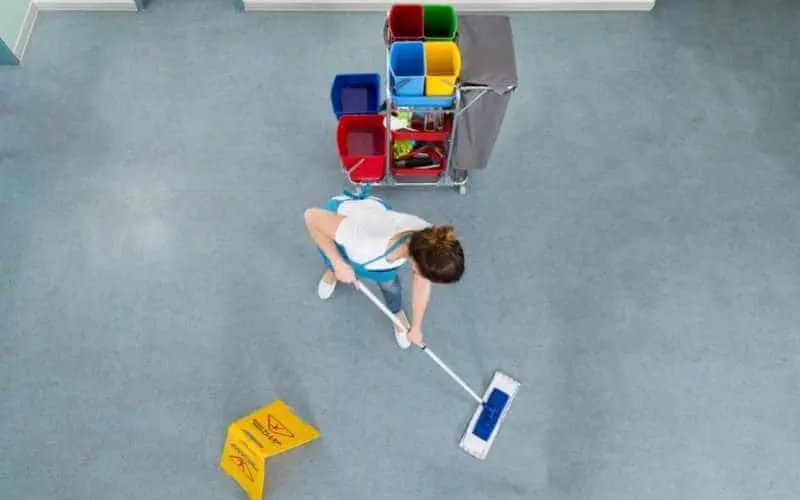Picture this: you’ve just finished a weekend DIY project, and a splash of paint, or worse, a spill of stubborn red wine has landed on your concrete floor. Panic sets in as you realize the stain won’t budge with a simple wipe. “Can I even use a steam mop on this?” you wonder. The good news is, you’re not alone! Many concrete floor owners grapple with this question, and we’re here to equip you with the knowledge to tackle those stains with confidence.

Image: floorcarekits.com
When it comes to cleaning concrete floors, a steam mop can be an amazing ally in your arsenal, but it’s not a one-size-fits-all solution. Understanding the nuances of steam mopping on concrete allows you to maximize its benefits while minimizing any potential risks.
The Power of Steam: A Deep Dive
Steam mopping is a cleaning technique that leverages the power of water vapor (steam) to loosen dirt, grime, and even some stains. Imagine tiny, high-pressure water particles penetrating the surface, loosening the bonds binding the dirt and grime. This gentle yet effective method makes steam mopping a popular choice for various surfaces, including tiles, hardwood, and yes, even concrete. But before you start steaming, it’s important to understand that not all concrete floors are created equal.
Types of Concrete and Their Compatibility
Concrete floors can be treated with various finishes and sealants, each impacting their reaction to steam. Here’s a breakdown:
- Unsealed Concrete: Unsealed concrete is porous, meaning it readily absorbs liquids, including water. While steam mopping may loosen dirt, it can also seep into the pores, potentially leading to further staining and damage.
- Sealed Concrete: Sealing concrete with a protective layer creates a barrier, making it less susceptible to absorption and potential damage from steam. The type of sealant used is crucial.
- Acrylic Sealants: Commonly used on concrete floors, acrylic sealants offer moisture resistance and durability. Steam mopping is usually safe on floors treated with acrylic sealants, given the sealant’s water-resistant nature.
- Epoxy Sealants: Epoxy sealants provide a robust, impermeable barrier that is highly resistant to water. While steam mopping on epoxy-sealed concrete is generally safe, exercise caution, as prolonged steam exposure might affect the sealant’s longevity.
Factors to Consider: Beyond the Concrete
Here are some key considerations when tackling those stubborn stains on your concrete floors using a steam mop:
- Type of Stain: While steam can tackle general grime, some stains, like oil-based paints and certain dye-based stains, are resistant to steam cleaning. These stubborn stains often require specialized cleaning agents and techniques.
- Age of the Stain: Freshly spilled stains are usually easier to remove, while older stains may have had time to penetrate deeper into the concrete.
- Severity of the Stain: A light stain might yield to steam cleaning, but deeply embedded stains could require more aggressive cleaning approaches.
- Steam Mop Settings: Different steam mops come with adjustable steam settings. Opt for a low or medium setting for concrete floors, especially if they are sealed.

Image: fisherjanis.blogspot.com
The Do’s and Don’ts of Steam Mopping Concrete
To ensure successful cleaning and protect your floors, follow these guidelines:
- Do: Always test a small hidden area of your concrete floor with a steam mop before going all out on the entire surface. This is essential to check for any negative reactions or discoloration.
- Do: If the floor is sealed, carefully read the sealant manufacturer’s recommendations on steam mopping.
- Do: Use a mild, pH-neutral cleaning solution specifically designed for steam mopping when possible. Avoid harsh chemicals that could harm the sealant or compromise the concrete.
- Don’t: Overuse steam on concrete floors. Excessive steam exposure can degrade sealant effectiveness and potentially cause damage.
- Don’t: Use high heat settings on unsealed concrete floors.
Alternative Cleaning Methods and Expert Advice
If you’re unsure about steam mopping or dealing with stubborn stains, consider these alternatives:
- Professional Cleaning Services: Professional floor cleaning services have the expertise, equipment, and cleaning agents to handle even the toughest stains on concrete.
- Concrete Cleaners: Specialty concrete cleaners are available at hardware stores and online. Choose a cleaner appropriate for your concrete type and the specific stain.
- DIY Stain Removal: Look for natural solutions like baking soda, vinegar, or hydrogen peroxide to tackle stains before considering harsh chemicals.
Can You Use A Steam Mop On Stained Concrete Floors
Conclusion
Steam mopping can be a valuable tool for cleaning concrete floors, but it’s crucial to approach it with knowledge and caution. Understanding your floor sealant, the type of stain, and how to properly use your steam mop can help you achieve a clean and fresh concrete floor without risking damage. So, the next time you face a stain on your concrete, remember: knowledge is power, and following these guidelines will empower you to make informed cleaning choices for a beautiful and lasting floor. Have you ever used a steam mop on your concrete floors? We’d love to hear your experiences in the comments!






